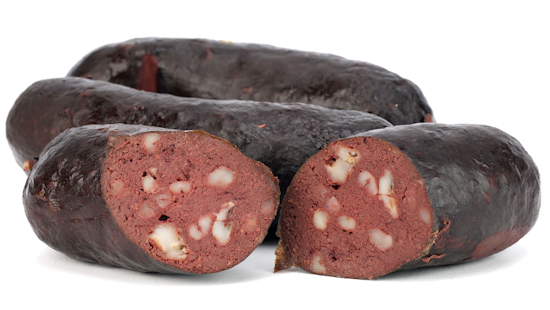Eat blood, drink bread: Musings on the global celebration of the savory.
Americans inherited the English language, but not the English gift for euphemism. So we do not call it “black pudding”; we call it blood sausage—a show of call-it-what-it-is practicality that may come from the frontier or from Germany or both.
That might also explain why it has never really taken off in the United States. Unless you hail from Bon Temps, La., the word “blood” is not so appetizing. But maybe it should be.
Blood sausage is a distillation of the savory, a carnivore’s delight, a remnant of when families and villages could not afford to waste a drop. It is literally the life’s blood of our precious animals, and using various means to turn that sacred liquid into food—coagulating, cooking down, adding fat or grains or herbs or spices, filling casings or baking, grilling or frying—is an ancient tradition in cultures around the world. Even Odysseus roasted goat paunches stuffed with “blood and fat.”
More to the point, it can be really damn tasty. And naturally, you will want something to wash it down. What better than a cool glass of beer?
Incidentally, this writing began as scribbles on a beer deckel at the Früh brewpub in Köln, Germany, over several stangen of kölsch beer and a small plate of kölsche kaviar. You know the beer, but maybe not the “caviar”: a simple blood sausage—in that region called a Flönz, and characterized by thick veins of fat—served with a crusty rye roll and raw onions. That’s it. Fried and served hot with mashed potatoes, it becomes himmel und erde, “heaven and earth.” Those who travel around Germany find that there are more variations on blutwurst than there are distinct regions, and that a beer is never far away.
In the British Isles, they call it “black pudding,” possibly to reassure squeamish children confronted with a traditional English breakfast—complete with mushrooms, tom-ah-toes, baked beans and so on. Typically, the sausage includes cooked oats as a filler. But like a fine cask ale, black pudding is not just for breakfast anymore. When asked for a pairing, accomplished British beer writer and gastronome Adrian Tierney-Jones offered this: “Old Peculier. The alcohol of the beer cuts through the fat, its restrained sweetness contrasts the salt. It could also heighten cereal notes in the pud. OK?” OK.
The French like to cook, you might have heard. In the monumental palace of French cuisine, in that extensive and celebrated wing called charcuterie, there is a special and rather large corner reserved for boudin noir. Variations include sheep or goat blood, but pork is usually the thing. They typically serve the sausages crispy from the pan with accompaniments that depend on region or whim—could be fried potatoes, apples, cabbage, chestnuts or watercress. A northern French amber ale—such as L’Ambrée d’Esquelbecq from Thiriez—has enough malt to perform the sweet-savory balancing act.
And just north of there, the Belgian love for blood sausage is such that every region seems to have its own name for it, even besides the Dutch bloedworst and French boudin noir. I’m partial to the Bruxellois version, called bloempanch. Wide in diameter like mortadella, its cross-sections revealing big chunks of fat, thickly sliced and served cold, bloempanch is more traditional to Brussels than bureaucracy. I heartily recommend a glass of authentic kriek cherry lambic like Cantillon’s, and at the surrealist café La Fleur en Papier Doré, if you can manage it.
So far that’s only a chunk of Western Europe. The more places you look, the more variations you find. Italy has sanguinaccio, in which the blood is sometimes mixed with chocolate and served as a sweet (perhaps with an Italian espresso stout, like Café Racer from Toccalmatto?). Spain and Latin America have morcilla; Uruguay makes a sweet version that can include raisins and pine nuts. In the United States, real butchers and artisanal charcutiers are becoming a thing again (naturally), often found in farmers markets and playing with things like kaszanka, a Polish treat that gets pig’s blood, offal, buckwheat and spices.
Asia’s numerous variations include my favorite thing I have never eaten: zhu xie gao, or “pig’s blood cake.” Taiwanese street vendors sell this oddity made of sticky rice and pig’s blood, rolled in peanut flour, and fried on a Popsicle stick. It typically comes with fresh cilantro and warms bellies with the intrepid spirit of Anthony Bourdain. I suspect he would follow the lead of locals and chase it with the rice lager called, simply, Taiwan Beer.
See? Blood on a stick. Nothing to be afraid of.










